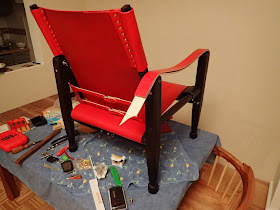Overnight I started thinking about my torched finish, and there are a couple things I forgot to mention. First, burning the wood is hard on sharp corners. A sharp arris will catch on fire a lot easier than the surrounding wood. This will create a bit of a roundover, but it is difficult to control. I planed a tiny chamfer on all of my 90 degree corners to assist with this problem. A related issue is the inside corners, as in a rebate or a molding do not darken as quickly as the surrounding wood. If the flame is left too long on those parts, the surrounding wood will char too much. I found brushing the wood pushes ashes out of the pores, and this can be used to brush the ashes into those corners to soften the look of a white stripe right there.
I also wanted to mention that brushing the wood does a couple of things. This wood is ash, which is ring pourous like oak. The early wood is made up of fat hollow tubes which you can see on the wood. Many finishes require you to use a wood filler to fill in these pores to get an even finish. What torching this wood does is burn away these porous parts a lot faster than the more dense latewood parts. Brushing the wood pulls all of the ashes of the early wood parts out, highlighting the grain's texture. It's a really neat effect.
Last, the fine horsehair brush that I used really polishes up the bare wood. This means that imperfections in the surface that were there before charring will still be there after. I had some small sections of tear out that I figured would even out after burning, but nope, they can still be seen.
Time to get some leather on this puppy. Here's what I now have to work with. My leather template can be seen on the floor.
The first thing I did was make the 3/4" belts that go side to side and are screwed to the legs. For these to work right, pilot holes need to be drilled.
 |
| It's weird to drill a hole in black wood and have white shavings come out. |
 |
| It took some real thought to get the most out of this leather. |
Besides it being very bright in color, it was a pretty small side of leather. There was barely enough to get the parts I needed. Let's just say the main parts now have very long belt straps. Luckily it works.
The good news was this leather was vegetable tanned and took to coloring really well. The color on this side doesn't go all the way through, so some treatment was needed for those parts. Because of time constraints, I only dyed the parts that are visible from the front.
In fact, the leather color/finish I bought matched perfectly, allowing me to blend the edges in perfectly. These parts look like they were cut at the factory.
Linda, if you would like to put some of this paint on the edges of the belts on the underside and the back, I would think you can buy this exact stuff from the saddle shop that Dad and I went to. Or, you can buy it online from Tandy Leather.
I screwed the arm straps on to the front like a Klindt Safari chair, and doubled up the leather arms with some thick 10 ounce veg-tan leather for extra stout arms.
Here my clamping set up is shown. I used Tandy's leather glue, which I think is just regular white PVA glue like Elmer's.
 |
| Since the leather was so thick on these arms, I laminated them together in place so the bend would have no wrinkles. |
I thought the circle pattern on the heads was a bit unsightly, so I polished them smooth on my sharpening stones. Over time these should darken up. The big benefit with these fasteners is over time if the arms start to sag, they can be tightened up.
Finished Chair
Part I
Part II
Part III
Part IV
Part V
Part VII









No comments:
Post a Comment